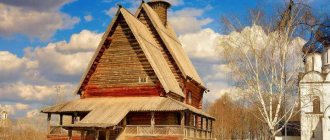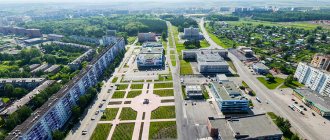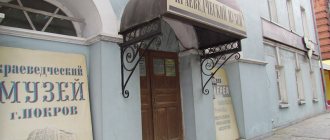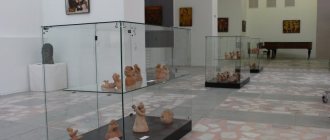One of the most picturesque cities in the Leningrad region is Vsevolozhsk. It arose on the site of a holiday village and a railway station built specifically for it. It received its name in honor of the founder Pavel Aleksandrovich Vsevolozhsky, who invested in the construction of the railway and became its shareholder. This place has always attracted St. Petersburg residents due to its nature, geographical location and special atmosphere. Pushkin visited here, the first cheese factory of Catherine II was once located here, during the Second World War the “Road of Life” passed through - the only thread connecting the mainland with besieged Leningrad. Today Vsevolozhsk is an attractive tourist route. The city has comfortable hotels and restaurants with interesting cuisine. There are few attractions in the city itself. They can be viewed in one day. The main value is natural areas. The city, like a hundred years ago, is one of the best vacation spots in the Leningrad region. From St. Petersburg there is an electric train from the Finlyandsky Station (Irinovskoe direction), minibuses from the Ladozhskaya and Ploshchad Lenina metro stations.
Economy
The city has a well-developed industry. At the same time, many large enterprises are located away from city blocks in the special industrial zone “Brick Factory” or in the communal and warehouse zone, although they do not pose a danger to residents and comply with international standards.
In the trade sector there are many shops, retail chains and shopping centers, and local entrepreneurs are also involved. The banking and insurance sectors and telecommunications are well developed. Very high rates of housing commissioning: this area is one of the leading in the Leningrad region. At the same time, the construction market is represented by a number of large companies.
With all this, the city is characterized by the so-called pendulum migration: many city residents work at enterprises in the region or even in St. Petersburg.
Unique nature
Whatever program you plan for yourself, you can be sure that Vsevolozhsk, the sights of which we looked at, will surprise you no less than any large city in Russia. Every person here will find something for themselves, something that is close to their heart. In addition to museums, memorials and temples, these places have incredibly beautiful nature, which you are unlikely to find anywhere else. The variety of colors that Vsevolozhsk is rich in is simply amazing. The attractions, the list of which is presented in the article, play an important role in this, but they are only part of everything that is so amazing in the city. For this reason, almost everyone who has ever been here wants to come back here again.
The Legend of the Red Castle
The “Swedish trace” was not lost in the land of the future Vsevolozhsk. A road runs through the territory of Rumbolovsky Park, which old-timers called “Swedish bridges” - in memory of the gates laid back in the 16th century by the Swedish commander Pontus Delagardie. The ancient tract, of which only a small section remains in the park, went from Kexgolm (Priozersk) through Ruutunsky Pogost (Sosnovo) to Ryabovo (Vsevolozhsk) and then diverged into two: through Kelts (Koltushi) to Noteburg (Oreshek) and Nyenshantz (Cape at confluence of the Neva and Okhta). The mysterious structure, the ruins of which are preserved on the slope of Rumbolovskaya Mountain, most likely dates back to the time of Nyenschanz. People call it the “Red Castle”.
It is not that difficult to understand who built it. It is known that Russians have always built churches and estates on hills. But Scandinavians never settle on the peaks: their houses are usually located in a hollow, where it is easier to shelter from the cold winds. In Rumbolovsky Park all this found its expression: the manor house of the Vsevolozhsk princes (and, possibly, Fredericks) was built at the very top of the mountain, and the “Red Castle” stands on the slope.
Before the revolution, the practical owners of these places adapted the building into a “master building” and built their house on top (designed by the famous architect Pavel Schröter). The manor house burned down in 1928, but the more ancient “Red Castle” has survived to this day (albeit in terrible condition).
Once upon a time, Rumbolovskaya Mountain was a stronghold where Swedish troops could stop to rest on their way to Ingermanland and further to Muscovy. Apparently, for this purpose, a castle of five tiers with two towers was built in a semi-desert and swampy area. Under the walls of the castle, deep underground, there were giant cellars in which, if desired, supplies for a small army could be stored. For a secretive retreat, a system of underground passages was dug inside the mountain (which became a cult favorite for later enthusiastic explorers). The beginning of one of these underground passages is located in Rumbolovsky Park in the area of a large well. The well itself, located right next to the castle walls, is also impressive: its diameter is more than two meters, which also says a lot.
Needless to say, the cellars and underground passages of the old castle have not yet been explored in detail by anyone.
What has already been built
Thanks to the online service Dom.MinZhKKH we learn a paradoxical thing. It turns out that the boom in multi-apartment construction in Vsevolozhsk occurred in the 1990s. The very ones that are now called “dashing” only. But precisely from 1990 to 1999, 105 houses with 5 thousand apartments were commissioned here. For comparison: in the next decade, half as many houses were built, and in 2010–2019 – 97 houses. True, there is an increase in the number of floors and building density, so that the apartment stock has increased by almost 10 thousand units over the past nine years.
We note that several dozen buildings built between 1910 and 1959 remain in the city. They are mostly wooden, and the real barracks have been preserved. In such houses you can buy a two-room apartment for 850 thousand rubles. – there is such a proposal in the public domain.
In the 60s, Khrushchev and brick Brezhnev buildings began to appear here. In the 70s, there was a boom in panel housing (in particular, the 137th, 504th and 606th series), and brick buildings were also built (528th series). The height of the buildings varies from two to nine floors with rare 12-story buildings.
In the 90s, it became possible to build apartment buildings based on individual projects, but large-format panels still prevailed. At the same time, the new Yuzhny microdistrict began to be built up - 32 houses appeared for military personnel withdrawn from Germany (this partly explains the above-mentioned construction boom).
New neighborhoods in the south of the Moskovsky district: a solid four
Which residential complexes will have the metro within walking distance?
What is being built in Rybatskoye: high-rise buildings with water views
Comfortable Shushary: new buildings at Pulkovsky
New buildings in Kamenka - west of Parachute Street
14-17-story buildings are already appearing - Yuzhny looks like a new St. Petersburg bedroom. But it is quite prosperous: there are several schools and kindergartens, a clinic and other infrastructure.
The supply on the secondary market is, for obvious reasons, mainly apartments in buildings built in the last 20 years: they make up more than half of the total housing stock.
Population[ | ]
| Population | |||||
| 2002[11] | 2006[12] | 2009[13] | 2010[14] | 2011[15] | 2012[16] |
| 45 530 | ↗46 100 | ↗48 287 | ↗60 018 | ↗60 135 | ↗60 642 |
| 2013[17] | 2014[18] | 2015[19] | 2016[20] | 2017[21] | 2018[22] |
| ↗62 390 | ↗64 598 | ↗66 480 | ↗68 147 | ↗70 523 | ↗73 126 |
| 2019[23] | 2020[24] | 2021[25] | |||
| ↗74 524 | ↗74 964 | ↗75 964 | |||
Ethnic composition of the Vsevolozhsk urban settlement according to the 2010 population census[26].
| № | Nationality | people |
| 1 | Azerbaijanis | 109 |
| 2 | Armenians | 607 |
| 3 | Bashkirs | 47 |
| 4 | Belarusians | 406 |
| 5 | Bulgarians | 8 |
| 6 | Buryats | 11 |
| 7 | Vepsians | 5 |
| 8 | Greeks | 4 |
| 9 | Georgians | 99 |
| 10 | Jews | 72 |
| 11 | Ingush | 6 |
| 12 | Kabardians | 10 |
| 13 | Kazakhs | 28 |
| 14 | Karelians | 19 |
| 15 | Kyrgyz | 48 |
| 16 | Komi | 9 |
| 17 | Koreans | 62 |
| 18 | Kumyks | 23 |
| 19 | Latvians | 9 |
| 20 | Lezgins | 21 |
| 21 | Lithuanians | 16 |
| 22 | Mari | 8 |
| 23 | Moldovans | 78 |
| 24 | Mordva | 28 |
| 25 | Germans | 35 |
| 26 | Ossetians | 21 |
| 27 | Poles | 19 |
| 28 | Russians | 54 432 |
| 29 | Tabasarans | 5 |
| 30 | Tajiks | 140 |
| 31 | Tatars | 323 |
| 32 | Turkmens | 10 |
| 33 | Udmurts | 6 |
| 34 | Uzbeks | 158 |
| 35 | Ukrainians | 1519 |
| 36 | Finns | 92 |
| 37 | Gypsies | 71 |
| 38 | Chechens | 4 |
| 39 | Chuvash | 30 |
| 40 | Estonians | 21 |
| 41 | Other nationalities | 31 |
| 42 | Didn't indicate nationality | 1354 |
| 43 | Total | 60 018 |
Cat Museum: description and opinions of visitors
What an amazing city Vsevolozhsk is! The attractions here are completely different.
For example, in Vsevolozhsk there is the only regular Russian cat museum. You will not find anything like this in any other corner of our country. So visit this place without any hesitation. Here you can find literally everything with cat paraphernalia or just something related to them. These are costumes, posters, and, of course, the animals themselves.
In total, the museum has brought together so many types of cats that it is simply impossible to remember the name of each, as well as to look at them. Naturally, the entire cat history, the process of domestication, is presented, and there is a description of the habits and habits of each breed.
This attracts visitors who, after visiting the museum, happily share their impressions and knowledge with others.
The city's attractions.
Since, it turns out, the city has quite a long and rich history, it, of course, has its own attractions: museums, architectural monuments and simply memorable places.
For example, in close proximity to the city there is the Priyutino estate - once its owner, A.N. Olenin, head of the Russian Academy of Arts, hosted the greatest representatives of our culture. Krylov, Venetsianov, Bryullov, Pushkin were here.
Now a museum exhibition is open here, and filmmakers often use the estate itself as a backdrop for filming. Vsevolozhsky’s manor house with a park has been preserved, only now it houses an agricultural technical school.
And the oldest existing building in the city is a cheese factory built in 1774, which was built on the initiative of the already mentioned Baron I. Yu. Fridriks.
There are also amazing ancient temples preserved in the city. The Church of the Savior Not Made by Hands and the Holy Trinity Church, for example, are considered architectural monuments of federal significance, and the Church of the Holy Trinity is a cultural and historical monument.
Relatively recently, several new churches were built: the Orthodox Church of St. Panteleimon (1996), the Orthodox Church of Saints Constantine and Helen (2001) and others.
There are several museums here: “Vsevolozhsk during the Siege”, the Museum of the History of Automobile Transport, and even the “Cat Museum”. Many memorials: “Rumbolovskaya Mountain” (part of the “Green Belt of Glory” monument complex), a monument to internationalist soldiers, liquidators of the Chernobyl nuclear power plant accident, soldiers who died in Chechnya, Heroes of the Second World War, the hero car - the “lorry”.
Bogoslovka Estate: description and opinion of tourists
This attraction will require a separate section. Its location is not entirely convenient. So it will take a certain amount of time to get there.
We are talking about the Bogoslovka Estate park complex, located in the Vsevolozhsk district. The park consists of several wooden buildings that show all the greatness of Russian architects. The beauty of the buildings so amazes everyone who visits this place that people are ready to return again and again. Not only the architecture, but also the pictures of nature, according to them, look simply amazing.
In this complex you will find a functioning church, a fortress and an ethnographic park, you will get a lot of pleasant impressions from what you see and will definitely understand those who praise this place so much.
Why was the city named Vsevolozhsk?
The manor changed many owners until it was finally purchased by landowner P.A. Vsevolozhsky. Mr. Vsevolozhsky became one of the shareholders in the construction of the Irinovskaya narrow-gauge railway, passing directly through his lands. And this fact made it possible for the landowner to express his desire that one of the railway stations be named Vsevolozhskaya. This is how Pavel Alexandrovich Vsevolozhsky went down in history - he named the city Vsevolozhsk.
It was in 1892, this date is now considered to be the date of the founding of the city of Vsevolozhsk. Then the Ryabovo estate was inherited by Vasily Pavlovich Vsevolozhsky, the son of the old owner. He remained its owner until 1917. He was a progressive man, an advanced industrialist: he modernized peasant labor, organized agricultural exhibitions on his estate following the example of the Parisian one, and founded the St. Petersburg Automobile Club.
In addition, he was a trustee of orphanages, traveling as a doctor at any time of the day or night to the sick, no matter what their origin, which earned him universal respect. Under him, the station settlement, which by that time had become a dacha settlement, began to actively grow.
Then revolutionary changes in the country turned the station into a workers' settlement, the population of which continued to increase. And so, over time, a whole city grew up on this site.
And during the Great Patriotic War, the city of Vsevolozhsk was crossed by the same Road of Life, which did not allow besieged Leningrad to die from hunger and disease, because it at least partially connected the exhausted city with the mainland.
In 1963, the city of Vsevolozhsk finally received officially city status.











